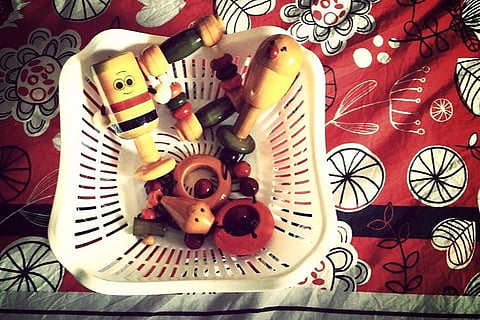

Come September and Karnataka's traditional Channapatna toys will be showcased at the London Design Fair 2017.
The toys get their name from Channapatna town in Ramanagara district which is known for its lacqueware art, especially wooden toys, bangles, rocking horses and dolls.
Made from soft ivory wood or hale mara, the products are coated with lacquer which is prepared from vegetable dyes. This is also the products’ USP since they use organic colours as opposed to those containing lead.
Home to over 5,000 artisans, Channapatna's journey to becoming the "toy town of Karnataka" is believed to have begun nearly 200 years ago under the reign of Tipu Sultan. The then ruler of Mysuru is said to have been gifted a lacquered-wood toy from Persia in the 18th century. Impressed by the craft, he brought artisans from Persia to train local artists in the craft.
Another possible and lesser-known theory, as Pavitra Jayaraman mentions in her piece for LiveMint, goes that the craft grew as a result of machine tools that were brought to Mysuru in the 19th century by the British.
"Both Tipu and Hyder Ali loved to experiment with new machinery and might have encouraged the use of lathes in making toys," aerospace scientist Roddam Narasimha told her.
By HPNadig, via Wikimedia Commons
In 2006, the Geographical Indications Registry granted a GI certificate to Channapatna toys. However, over the years, the craft's existence has been threatened by the availability of cheaper Chinese imports.
Media reports have regularly highlighted how traditional craftsmen from the town have moved on to other professions or migrated to cities to earn better livelihoods.
In 2015, Atul Johri, an art designer from Lucknow who has settled in Channapatna, told The Hindu that Channapatna was slowly losing the very art of lacquering that it was known for.
"The whole world knew what Channapatna dolls and toys were. Their lathe turning and lacquerware spoke of their unique character. When the European market opened up to Channapatna in the 1970s for wooden napkin rings, lakhs of such rings were exported worldwide,” says Johri.
However, this is also when, he thinks, the downfall of the craft began.
"I would think Channapatna’s downfall started with the napkin exports taking off, as Europeans unfortunately didn’t want the lacquering expertise to go on the rings, but preferred uniform, single tone coloured ones. This 'faded' the art of lacquering that demands shades of tonal gradations. Tonal gradation, which was slowly forgotten since the 1990s, is what I wanted to take up for the progress of the trade."
By Hari Prasad Nadig/Flickr
There have been sustained efforts from independent artists, NGOs and the government to revive the iconic craft and give it a wider reach while keeping the artisan's well-being in mind.
The product range today is much more diversified, modern machinery has been introduced to aid in the manufacturing of the products and they can also be bought online.
During her visit to India in 2010 along with former President of USA Barack Obama, wife Michelle had picked up colourful Channapatna toys at the National Handicrafts and Handloom Museum in New Delhi.
Today, Channapatna toys can be found across many parts of the world with some even adorning the shelves of The White House.